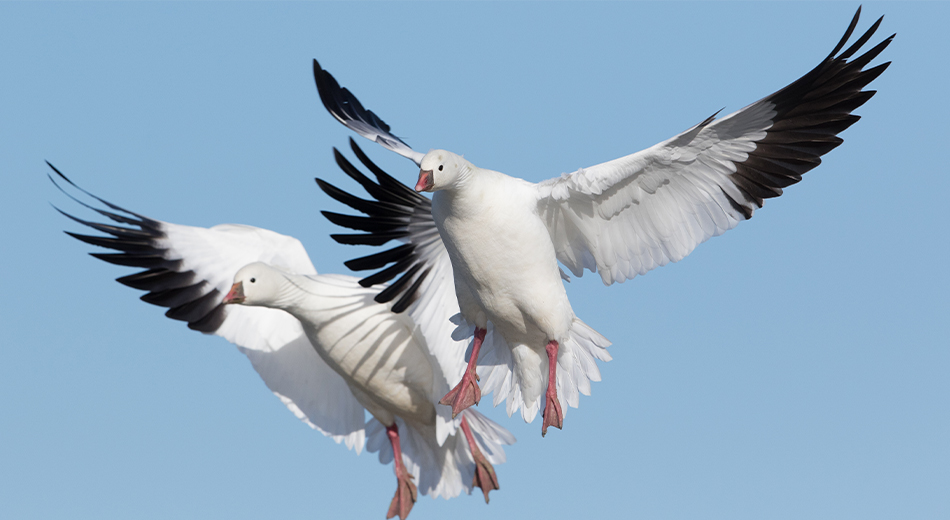
Ross’s Geese, AP Canada Geese, and Midcontinent Specklebellies Increase
Ducks might dominate the headlines when the annual Waterfowl Population Status Report is released, but the report also contains critical insights for the upcoming goose season. Here’s a breakdown of everything you need to know.
Most populations of North America’s geese nest in the Arctic and Subarctic from Russia to Greenland, so production is dependent on a timely thaw of ice and snow cover. Typically, production lags when nesting is delayed or a widespread major weather event occurs during nesting. Fortunately, many nesting areas experienced average to above average temperatures in May and June, resulting in early or average nest initiation timing across most areas in the Subarctic and Arctic, although later-than-average nest initiation occurred in some areas of Northern Alaska and the western Canadian Arctic.
“Population estimates for many goose groups are encouraging this year, particularly for light geese and the Atlantic Population of Canada geese,” said Dr. Chris Nicolai, waterfowl scientist for Delta Waterfowl. “Coupled with average to above-average spring productivity reported by banding crews across much of the Arctic, the data points to good prospects for hunters this season.”
Starting with Canada geese, the Atlantic Flyway’s resident goose population remains strong and stable, increasing 8% over 2024 to an estimate of 1 million, which is equal to the 10-year average. This bodes well for waterfowlers in New York, Pennsylvania, and the Chesapeake Bay’s Eastern Shore. Atlantic Flyway waterfowlers currently facing restrictive limits will also be pleased to hear that the Atlantic Population of Canada geese, which winters in highest concentrations on the Delmarva Peninsula, increased 68% to 150,000. AP geese remain 3% below the 10-year average, and spring productivity of AP Canada Geese from the Ungava Peninsula was reported extensively lower than the long-term average in Nunavut, meaning less easy-to-decoy juvies this fall.
Farther west, the breeding population estimate of Mississippi Flyway giant Canada geese—a huge resident flock that stretches from southern Ontario and Manitoba across Mississippi Flyway states—was nearly equivalent to 2024’s tally at 1.43 million and equal to the 10-year average.
The Central Flyway’s Western Prairie and Great Plains population—in recent years, the continent’s largest and fastest-growing flock to the delight of hunters from Saskatchewan to Oklahoma—remains strong and stable, seeing a 4% increase at 1.17 million but 3% below the 10-year average.
Population estimates and breeding conditions were positive for dark geese in the Pacific Flyway. Western (Pacific) Canada geese increased 33% to 425,000, still 2% below the 10-year average; Aleutian cackling geese increased 27% to 205,000 at 2% above the 10-year average; and cackling (minima) geese remained consistent with 2024’s tally of 124,000 birds—9% below the 10-year average—while large brood sizes and abundant goslings this spring signal average to above average production.
On North America’s light geese which primarily nest in the arctic, key populations have increased.
“Arctic geese have had relatively poor production in the last decade, but we’ve been climbing out of it the last three or four years,” said Frank Baldwin, a waterfowl biologist for the Canadian Wildlife Service who focuses on arctic nesting geese and spent early August working on banding operations. “This year is another year where there were no big busts in production, and average in some areas and above average in others.”
Large flights of migrating Ross’s geese should be headed to California and Texas as spring production was above average, and the most recent breeding estimate was at 3.41 million, an outstanding 217% increase, but still 7% below the 10-year average.
The Midcontinent population of lesser snow geese made a promising increase of 71% to 7.99 million, though 12% below the 10-year average. Baldwin stated that crews observed above-average production in the Central Arctic, average production in Southhampton and West Hudson Bay, and slightly below average production on Baffin Island for Midcontinent snows—good news which bodes well for juvenile midcontinent populations hovering over decoys this fall.
In less enthusiastic news for greater snow goose hunters from New Jersey to North Carolina, that population has declined 32% from 2024, estimated at 428,000. However, banding reports suggest good production for this population. While the Western Arctic population declined 11% to 1 million, 2% below the 10-year average.
In terms of specklebellies, California should see an improved flight of Pacific population white-fronted geese as they have increased 13% to 469,000, remaining 6% below the 10-year average. Following last year’s disappointing survey data, the midcontinent white-fronted goose population has improved considerably, up 115% at 2.75 million and 4% below the 10-year average.
Atlantic brant have increased 19% to 134,000, remaining 4% below the 10-year average, and had strong spring production, while the most recent Pacific brant numbers were reported at 189,000, a 23% decrease. Emperor geese also saw a welcome increase of 29% to 22,000, remaining 5% below the 10-year average.
Overall, the consensus on breeding populations and spring goose production is positive, and hunters can look forward to a good season.—Christy Sweigart
